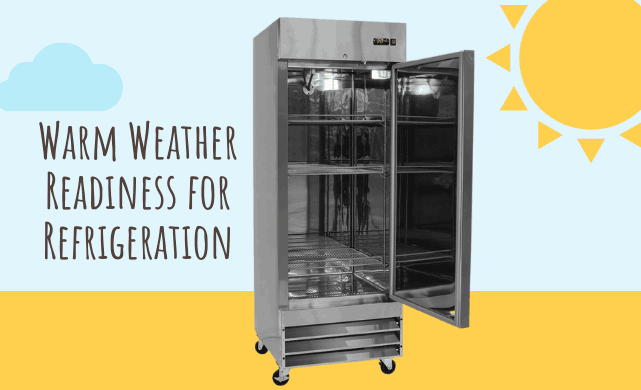Warm Weather Readiness for Refrigeration
If you're in one of the regions in the U.S. observing daylight saving time, you're likely preparing to "spring forward." For those who don't follow daylight saving time, it essentially means that this weekend, we'll shift our clocks forward by an hour. The idea behind this is to maximize daylight in the evenings rather than the mornings, signaling the approach of warmer weather, longer days, and rising temperatures. While this change brings about the excitement of outdoor activities like baseball games and picnics, it can pose challenges for foodservice equipment in commercial kitchens. As temperatures begin to rise outdoors, they also climb indoors, putting additional strain on refrigeration systems such as refrigerators, freezers, and walk-in coolers. These systems work harder to maintain consistent temperatures, increasing the risk of malfunctions and product spoilage. However, there are proactive measures you can take to keep your equipment running smoothly before the mercury rises. First and foremost, it's crucial to clean and inspect your refrigeration system. Heat is the nemesis of any commercial refrigeration setup, and summertime heat exacerbates the issue. The condenser coil, located within the condensing unit, plays a key role in releasing heat from the refrigerant during the cooling process. A clogged or dirty coil impedes this heat exchange, forcing the system to work harder and potentially shortening its lifespan. Regularly cleaning the coil as part of your monthly maintenance routine can significantly improve the performance of your refrigeration units. You can use a coil brush or vacuum cleaner for basic cleaning, and for stubborn debris, a shop vac or blower tool can be effective. In addition to cleaning the condenser coil, it's equally important to maintain the evaporator coils, especially in walk-in refrigerators and freezers. These components should be cleaned every six months, or more frequently if your kitchen operates in a dusty environment. Proper airflow is essential for efficient cooling, so always check that fans are functioning correctly and clear any obstructions. Wipe down fan blades and motors with warm soapy water to keep them clean. For the evaporator coil, use a soft-bristle brush and a vacuum to remove accumulated dust. When it comes to positioning your kitchen equipment, especially refrigeration units, placement is critical. Direct sunlight can hinder the cooling process, so it's best to place reach-in refrigerators away from windows. Adequate clearance around your coolers and freezers is another important consideration. Ensure there's enough space around these units to allow warm air expelled by the condensing unit to dissipate effectively. Always refer to your equipment manual for the recommended clearance distances. Having sufficient space not only improves efficiency but also makes it easier to access your equipment for regular maintenance. Checking the seals and gaskets on your refrigeration units is another vital step. Even minor gaps can lead to increased energy consumption as the system struggles to maintain the desired temperature. Often, these leaks occur due to worn-out gaskets or misaligned doors. During routine maintenance, examine the doors to confirm they close tightly. In walk-in units, door closers or hinges may need adjustments to ensure a snug fit. Additionally, inspect the rubber gaskets along the door edges and replace any that are cracked or torn. The transition to warmer weather presents unique challenges for refrigeration systems, but with preventive care and regular inspections, you can keep your equipment operating efficiently year-round. Addressing potential issues promptly helps prevent costly breakdowns and food losses while ensuring you can provide quality service to your customers.

Keywords: Refrigeration Maintenance Tips
Automotive Windshield Protection Film,Car Windshield Protection Film,Safety Windshield Protection Film,Explosion Proof Windshield Protection Film
Jiangsu Yaosheng New Materials Co.,Ltd , https://www.yscarfilm.com




